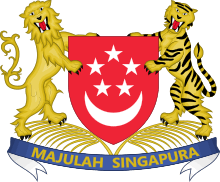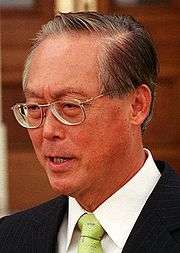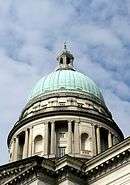Prime Minister of Singapore
| Prime Minister of the Republic of Singapore | |
|---|---|
 Prime Minister's Crest | |
| Style | The Honourable |
| Residence | Sri Temasek |
| Appointer | President of the Republic of Singapore |
| Term length |
5 years or earlier, renewable. The Parliament of Singapore must be dissolved every 5 years or earlier by the Prime Minister. The leader of the majority party in the parliament will become the Prime Minister. |
| Inaugural holder | Lee Kuan Yew |
| Formation | 3 June 1959 |
| Salary | S$2.2 million annually |
| Website |
www |
 |
|---|
| This article is part of a series on the politics and government of Singapore |
| Constitution |
| Foreign relations |
|
Related topics |
The Prime Minister of the Republic of Singapore (Malay: Perdana Menteri Republik Singapura; Chinese: 新加坡共和国总理, pinyin: Xīnjiāpō gònghéguó zǒnglǐ; Tamil: சிங்கப்பூர் குடியரசின் பிரதமர், Ciṅkappūr kuṭiyaraciṉ piratamar) is the head of the government of the Republic of Singapore, and the most powerful person in Singapore. The President of Singapore appoints as Prime Minister a Member of Parliament (MP) who, in his or her opinion, is most likely to command the confidence of a majority of MPs. In practice, the Prime Minister is usually the leader of the majority party in the legislature.
Under the Constitution of Singapore, executive power is vested in the President. However, the Constitution also vests "general direction and control of the government" in the Cabinet. The President is almost always bound to act on the advice of the Cabinet or any minister acting under Cabinet authority. Thus, in practice, most of the actual work of governing is done by the Prime Minister and Cabinet. The office of Prime Minister dates back to 1959 and was appointed at first by the Governor of Singapore then the Yang di-Pertuan Negara (vice-regal head of state), when Singapore achieved self-governance as the State of Singapore within the British Empire. The title of Prime Minister remained unchanged after the merger with the Federation of Malaya, Sarawak and North Borneo, while Singapore was a state in the Federation of Malaysia from 1963 to 1965, and after independence in 1965.
The late Lee Kuan Yew was the first prime minister of Singapore from 1959 to 1990. Lee was succeeded by Goh Chok Tong and was conferred the title of Senior Minister in the Prime Minister's Office. Goh retired on 12 August 2004 and was succeeded by Lee Kuan Yew's son Lee Hsien Loong. Goh was appointed Senior Minister, and the elder Lee Minister Mentor. Lee and Goh resigned from the Cabinet in 2011 but remained as members of Parliament.
List of Prime Ministers of Singapore (1959–present)[1]
| Portrait | Name (birth and death) Constituency |
Term of office | Party | Time in office | |||
|---|---|---|---|---|---|---|---|
| 1 |  |
Lee Kuan Yew 李光耀 லீ குவான் இயூ (1923–2015) MP for Tanjong Pagar GRC, 1955-2015 |
5 June 1959 | 28 November 1990 | 31 years, 178 days | ||
| 1959, 1963, 1968, 1972, 1976, 1980, 1984, 1988 | |||||||
| The first Prime Minister of Singapore and the youngest to be elected in the office, at the age of 35. He is the longest-serving Prime Minister of Singapore. His tenure led to the expansion of Singapore's economy from a British Crown Colony into a first world country. He introduced the National Service (NS) scheme, with the help of his Defence Minister Goh Keng Swee. He introduced the Stop-At-Two child policy in 1960s, for fearing of over expansion of Singapore population. In the 1980s, he introduced the Graduate Mother Scheme to counter the effects of the previous policy, which received a huge backlash. The policy was withdrawn shortly thereafter. He led the PAP into 8 consecutive election victories. During his tenure, Singapore grew to become the most prosperous nation in South-east Asia.[2] | |||||||
| 2 |  |
Goh Chok Tong 吴作栋 கோ சொக் தொங் (b. 1941) MP for Marine Parade GRC, 1988- |
28 November 1990 | 12 August 2004 | 13 years, 258 days | ||
| 1991, 1997, 2001 | |||||||
| The second Prime Minister of Singapore. He introduced several major policies and policy institutions, such as Medisave, Non-constituency Members of Parliament, Government Parliamentary Committees, Group Representation Constituencies, Nominated Members of Parliament, the Vehicle Quota Scheme, the direct election of the President and Singapore 21. During his tenure Singapore experienced several crises, such as the 1997 Asian financial crisis, threats of terrorism including the 2001 Singapore embassies attack plot by Jemaah Islamiyah, the 2001–2003 economic recession, and the 2003 SARS outbreak. He also introduced the Baby Bonus scheme in a bid to increase birth rates. Prior his appointment as PM, he served as Senior Minister of State for Finance, Minister for Trade and Industry, Minister for Health, Minister for Defence and first Deputy Prime Minister.[3] | |||||||
| 3 |  |
Lee Hsien Loong 李显龙 லீ சியன் லூங் (b. 1952) MP for Ang Mo Kio GRC, 1991- |
12 August 2004 | Incumbent | 14 years, 70 days | ||
| 2006, 2011, 2015 | |||||||
| The third Prime Minister of Singapore. He introduced the five-day working week for civil servants, with the hope of increasing the birth rate. One of his major accomplishments was to propose the building of 2 Integrated Resorts (IR) in Singapore. It created a huge avenue for Singapore's economy. Singapore hosted the inaugural summer Youth Olympic Games in 2010. He promoted the abolition of school ranking. In 2013, he presided over the worst haze crisis and worst Dengue epidemic in Singapore. Prior to his appointment as PM, he served as Deputy Prime Minister (1991–2004), Minister of Finance, Minister of Trade and Industry. | |||||||
Timeline

Living former Prime Ministers
| Name | Term of office | Date of birth |
|---|---|---|
| Goh Chok Tong | 20 May 1941 | |
List of Deputy Prime Ministers
The role of Deputy Prime Minister is the second-highest post and senior Cabinet Minister in Singapore. The holder will sometimes assume the role of Acting Prime Minister when the PM is temporarily absent. Since the mid-1980s, Singapore has usually had two Deputy Prime Ministers at a time. Only Ong Teng Cheong and Tony Tan served under more than one Prime Minister during their time as Deputy Prime Minister.
In the cabinet of Goh Chok Tong in the 1990s to 2004, current Prime Minister Lee Hsien Loong and former President Tony Tan were the deputy prime ministers, with the latter only joining after Ong Teng Cheong officially left to fulfill his term as the President of Singapore.
Currently, the deputy prime ministers in office are Mr Teo Chee Hean and Mr Tharman Shanmugaratnam, with the latter joining after the resignation of Wong Kan Seng.
See also
References
- ↑ Singapore, National Library Board,. "Past and present leaders of Singapore | Infopedia". eresources.nlb.gov.sg. Retrieved 2018-09-22.
- ↑ "Lee Kuan Yew | prime minister of Singapore". Encyclopedia Britannica. Retrieved 2018-09-22.
- ↑ "Impressions of the Goh Chok Tong Years in Singapore". NUS Press. Retrieved 2018-09-22.
External links
| Wikimedia Commons has media related to Prime Ministers of Singapore. |


